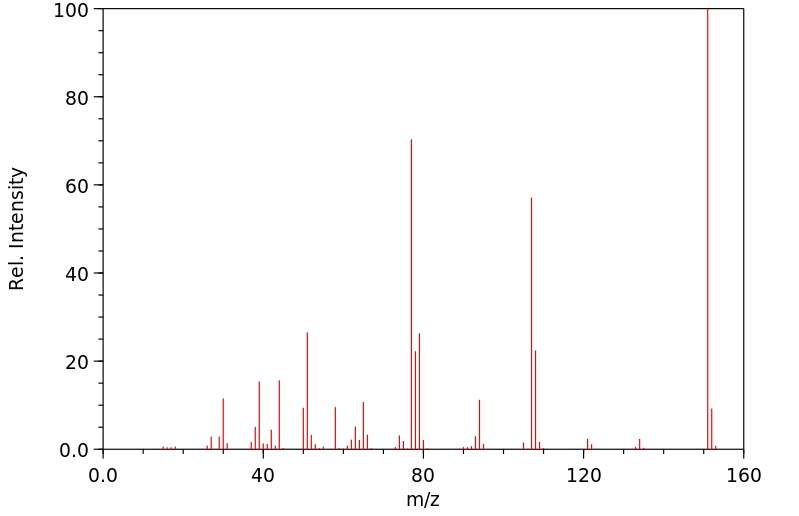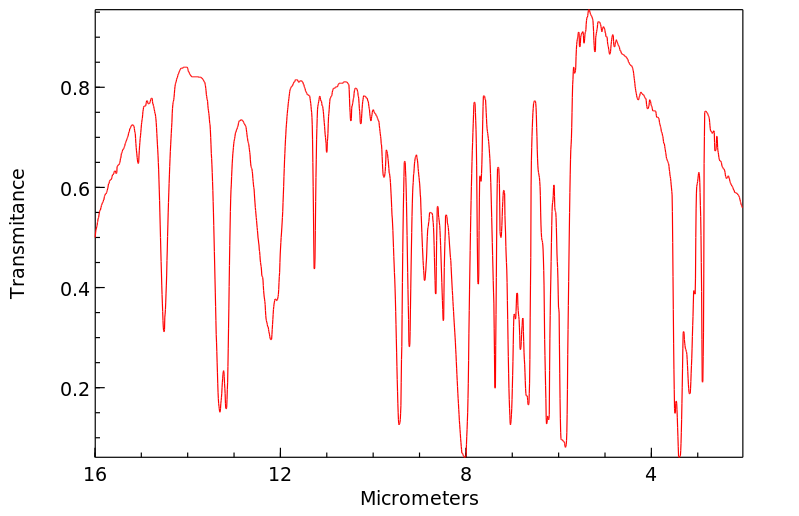苯氧乙酰胺 | 621-88-5
中文名称
苯氧乙酰胺
中文别名
2-苯氧乙酰胺;2-苯氧基乙酰胺;苯氧乙醯胺
英文名称
phenoxyacetamide
英文别名
2-(phenoxy)acetamide;2-Phenoxyacetamide
CAS
621-88-5
化学式
C8H9NO2
mdl
MFCD00017140
分子量
151.165
InChiKey
AOPRXJXHLWYPQR-UHFFFAOYSA-N
BEILSTEIN
——
EINECS
——
-
物化性质
-
计算性质
-
ADMET
-
安全信息
-
SDS
-
制备方法与用途
-
上下游信息
-
文献信息
-
表征谱图
-
同类化合物
-
相关功能分类
-
相关结构分类
物化性质
-
熔点:101-103 °C(lit.)
-
沸点:273.17°C (rough estimate)
-
密度:1.2023 (rough estimate)
-
溶解度:21 [ug/mL]
-
稳定性/保质期:
避免使用强酸、强碱、强氧化剂和强还原剂。
计算性质
-
辛醇/水分配系数(LogP):0.8
-
重原子数:11
-
可旋转键数:3
-
环数:1.0
-
sp3杂化的碳原子比例:0.125
-
拓扑面积:52.3
-
氢给体数:1
-
氢受体数:2
安全信息
-
TSCA:Yes
-
危险等级:IRRITANT
-
危险品标志:Xn,Xi
-
安全说明:S26,S36
-
危险类别码:R20/21/22
-
WGK Germany:3
-
海关编码:2924299090
-
储存条件:存放于充满惰性气体的密封容器中,并置于阴凉、干燥处,以避免湿气影响。
SDS
| Name: | Phenoxyacetamide 99% Material Safety Data Sheet |
| Synonym: | |
| CAS: | 621-88-5 |
Synonym:
Section 2 - COMPOSITION, INFORMATION ON INGREDIENTS
| CAS# | Chemical Name | content | EINECS# |
| 621-88-5 | Phenoxyacetamide | 99% | 210-713-0 |
Risk Phrases: None Listed.
Section 3 - HAZARDS IDENTIFICATION
EMERGENCY OVERVIEW
The toxicological properties of this material have not been fully investigated.
Potential Health Effects
Eye:
May cause eye irritation.
Skin:
May cause skin irritation.
Ingestion:
May cause irritation of the digestive tract. The toxicological properties of this substance have not been fully investigated.
Inhalation:
May cause respiratory tract irritation. The toxicological properties of this substance have not been fully investigated.
Chronic:
None
Section 4 - FIRST AID MEASURES
Eyes: Flush eyes with plenty of water for at least 15 minutes, occasionally lifting the upper and lower eyelids. Get medical aid.
Skin:
Get medical aid if irritation develops or persists. Flush skin with plenty of soap and water.
Ingestion:
If victim is conscious and alert, give 2-4 cupfuls of milk or water.
Never give anything by mouth to an unconscious person. Get medical aid.
Inhalation:
Remove from exposure and move to fresh air immediately. Get medical aid if cough or other symptoms appear.
Notes to Physician:
Section 5 - FIRE FIGHTING MEASURES
General Information:
As in any fire, wear a self-contained breathing apparatus in pressure-demand, MSHA/NIOSH (approved or equivalent), and full protective gear.
Extinguishing Media:
Use water spray, dry chemical, carbon dioxide, or chemical foam.
Section 6 - ACCIDENTAL RELEASE MEASURES
General Information: Use proper personal protective equipment as indicated in Section 8.
Spills/Leaks:
Vacuum or sweep up material and place into a suitable disposal container. Avoid generating dusty conditions.
Section 7 - HANDLING and STORAGE
Handling:
Wash thoroughly after handling. Use with adequate ventilation.
Minimize dust generation and accumulation. Avoid contact with eyes, skin, and clothing. Avoid ingestion and inhalation.
Storage:
Store in a tightly closed container. Store in a cool, dry, well-ventilated area away from incompatible substances.
Section 8 - EXPOSURE CONTROLS, PERSONAL PROTECTION
Engineering Controls:
Use adequate ventilation to keep airborne concentrations low.
Exposure Limits CAS# 621-88-5: Personal Protective Equipment Eyes: Wear appropriate protective eyeglasses or chemical safety goggles as described by OSHA's eye and face protection regulations in 29 CFR 1910.133 or European Standard EN166.
Skin:
Wear appropriate protective gloves to prevent skin exposure.
Clothing:
Wear appropriate protective clothing to prevent skin exposure.
Respirators:
Follow the OSHA respirator regulations found in 29 CFR 1910.134 or European Standard EN 149. Use a NIOSH/MSHA or European Standard EN 149 approved respirator if exposure limits are exceeded or if irritation or other symptoms are experienced.
Section 9 - PHYSICAL AND CHEMICAL PROPERTIES
Physical State: Solid
Color: white
Odor: Not available.
pH: Not available.
Vapor Pressure: Not available.
Viscosity: Not available.
Boiling Point: Not available.
Freezing/Melting Point: 96 - 99 deg C
Autoignition Temperature: Not available.
Flash Point: Not available.
Explosion Limits, lower: Not available.
Explosion Limits, upper: Not available.
Decomposition Temperature:
Solubility in water:
Specific Gravity/Density:
Molecular Formula: C8H9NO2
Molecular Weight: 151.17
Section 10 - STABILITY AND REACTIVITY
Chemical Stability:
Stability unknown.
Conditions to Avoid:
Incompatible materials.
Incompatibilities with Other Materials:
Strong oxidizing agents - strong reducing agents - strong acids - strong bases.
Hazardous Decomposition Products:
Nitrogen oxides, carbon monoxide, carbon dioxide.
Hazardous Polymerization: Has not been reported
Section 11 - TOXICOLOGICAL INFORMATION
RTECS#:
CAS# 621-88-5 unlisted.
LD50/LC50:
Not available.
Carcinogenicity:
Phenoxyacetamide - Not listed by ACGIH, IARC, or NTP.
Section 12 - ECOLOGICAL INFORMATION
Section 13 - DISPOSAL CONSIDERATIONS
Dispose of in a manner consistent with federal, state, and local regulations.
Section 14 - TRANSPORT INFORMATION
IATA
Not regulated as a hazardous material.
IMO
Not regulated as a hazardous material.
RID/ADR
Not regulated as a hazardous material.
Section 15 - REGULATORY INFORMATION
European/International Regulations
European Labeling in Accordance with EC Directives
Hazard Symbols: Not available.
Risk Phrases:
Safety Phrases:
S 26 In case of contact with eyes, rinse immediately
with plenty of water and seek medical advice.
S 36/37/39 Wear suitable protective clothing, gloves
and eye/face protection.
WGK (Water Danger/Protection)
CAS# 621-88-5: No information available.
Canada
CAS# 621-88-5 is listed on Canada's NDSL List.
CAS# 621-88-5 is not listed on Canada's Ingredient Disclosure List.
US FEDERAL
TSCA
CAS# 621-88-5 is listed on the TSCA inventory.
SECTION 16 - ADDITIONAL INFORMATION
N/A
上下游信息
-
上游原料
中文名称 英文名称 CAS号 化学式 分子量 —— N-hydroxy-2-phenoxyacetamide 46120-83-6 C8H9NO3 167.164 苯氧乙酰肼 phenoxyacetyl hydrazine 4664-55-5 C8H10N2O2 166.18 苯氧乙酸 2-phenoxyacetic acid 122-59-8 C8H8O3 152.15 苯氧乙酰氯 Phenoxyacetyl chloride 701-99-5 C8H7ClO2 170.595 2-苯氧基乙腈 phenoxyacetonitrile 3598-14-9 C8H7NO 133.15 苯氧乙酸甲酯 methyl 2-phenoxyacetate 2065-23-8 C9H10O3 166.177 苯氧乙酸乙酯 phenoxyacetic acid ethyl ester 2555-49-9 C10H12O3 180.203 —— phenyl phenoxyacetate 25774-60-1 C14H12O3 228.247 -
下游产品
中文名称 英文名称 CAS号 化学式 分子量 2-苯氧基乙胺 2-phenoxyethanamine 1758-46-9 C8H11NO 137.181 乙酰胺,N,N-二甲基-2-苯氧基- N,N-dimethyl-α-phenoxyacetamide 10397-59-8 C10H13NO2 179.219 —— Phenoxyacetyl-isocyanat 4461-31-8 C9H7NO3 177.159 —— 2-(4-chlorophenoxy)acetamide 3598-10-5 C8H8ClNO2 185.61 苯氧乙酸 2-phenoxyacetic acid 122-59-8 C8H8O3 152.15 2-苯氧基硫代乙酰胺 2-phenoxyethanethioamide 35370-80-0 C8H9NOS 167.232 2-苯氧基乙腈 phenoxyacetonitrile 3598-14-9 C8H7NO 133.15 苯氧乙酸甲酯 methyl 2-phenoxyacetate 2065-23-8 C9H10O3 166.177 苯氧乙酸乙酯 phenoxyacetic acid ethyl ester 2555-49-9 C10H12O3 180.203 —— 2-phenoxy-N-phenylacetamide 18705-01-6 C14H13NO2 227.263 (2,4-二氯苯氧基)乙酰胺 2-(2,4-dichlorophenoxy) acetamide 1982-42-9 C8H7Cl2NO2 220.055 - 1
- 2
反应信息
-
作为反应物:描述:参考文献:名称:Fritzsche, Journal fur praktische Chemie (Leipzig 1954), 1879, vol. <2> 20, p. 283摘要:DOI:
-
作为产物:参考文献:名称:使用氨基甲酸酯类作为胺源,由未活化的羧酸直接催化形成伯酰胺和叔酰胺摘要:操作简便的钛(IV)或锆(IV)催化的非活化羧酸与氨基甲酸铵的直接酰胺化反应可生成伯,叔N,N-二甲基取代的酰胺,产率高至优异。DOI:10.1002/adsc.201200436
文献信息
-
腈及其相应胺的制造方法申请人:中国石油化工股份有限公司公开号:CN104557610B公开(公告)日:2018-04-27本发明涉及一种腈的制造方法,与现有技术相比,具有氨源用量显著降低、环境压力小、能耗低、生产成本低、腈产物的纯度和收率高等特点,并且能够获得结构更为复杂的腈。本发明还涉及由该腈制造相应胺的方法。
-
Selective conversion of primary amides to esters promoted by KHSO4作者:Narsimha Sattenapally、Jhanvi Sharma、Yuqing HouDOI:10.24820/ark.5550190.p010.392日期:——Primary amides, either aliphatic or aromatic, are easily converted to the corresponding esters via reflux in lower primary alcohols in the presence of KHSO4. Secondary amides lead to complicated mixtures under analogous conditions, whereas tertiary amides were inert. Use of isopropyl alcohol resulted in the formation of product at slower rate and lower yield along with side products, whereas, use of
-
IMIDAZO 1, 2-A PYRIMIDINE DERIVATIVES FOR THE TREATMENT OF DISEASES SUCH AS DIABETES申请人:Klein Markus公开号:US20100249151A1公开(公告)日:2010-09-30Novel compounds of the formula (I), in which W, T, R 1 , R 2 , R 3 , R 4 , R 5 , R 6 and X 7 have the meanings indicated in Patent Claim 1 , are suitable as antidiabetics.化合物的新颖结构式(I),其中W、T、R1、R2、R3、R4、R5、R6和X7的含义如专利权要求书中所示,适用于抗糖尿病药物。
-
Method for synthesizing oxazinones申请人:——公开号:US20030232820A1公开(公告)日:2003-12-18New methods and intermediates are discussed for the stereospecific synthesis of oxazinone compounds.讨论了用于氧杂环酮化合物立体特异合成的新方法和中间体。
-
Pyrrolopyrimidine A2b selective antagonist compounds, their synthesis and use申请人:——公开号:US20030229067A1公开(公告)日:2003-12-11The subject invention provides compounds having the structure: 1 wherein, R 1 is a substituted or unsubstituted alkyl, wherein the substituent is hydroxyl, dihydroxy, carboxyl, —C(═O)NR a R b , —NR a R b , —NR a C(═O)NR a R b , —NR a C(═O)OR a , —OC(═O)NR a R b , or —NHC(═O)R a ; R 2 is hydrogen or a substituted or unsubstituted alkyl, wherein the substituent is hydroxyl, dihydroxy, carboxyl, —C(═O)NR a R b , —NR a R b , —NR a C(═O)NR a R b , —NR a C(═O)OR a , —OC(═O)NR a R b , or —NHC(═O)R a , or R 1 , R 2 and N together form a substituted piperazine, substituted azetidine ring, or a pyrrolidine ring substituted with —(CH 2 ) 2 OH or —CH 2 C(═O)OH; R 3 is a substituted or unsubstituted phenyl or a 5-6 membered heteroaryl ring, wherein the substituent is halogen, hydroxyl, cyano, (C 1 -C 15 )alkyl, (C 1 -C 15 )alkoxy, or —NR a R b ; R 4 is hydrogen or substituted or unsubstituted (C 1 -C 15 )alkyl; R 5 is —(CH 2 ) m OR 6 , —CHNOR 7 , —C(═O)NR 8 R 9 , —(CH 2 ) m C(═O)OR 10 , —(CH 2 ) k C(═O)NR 11 R 12 ; wherein R 6 is a substituted or unsubstituted (C 1 -C 30 )alkyl, (C 3 -C 10 )cycloalkyl, or an aryl, heteroaryl or 4-8 membered heterocyclic ring; R 7 is hydrogen, or a substituted or unsubstituted (C 1 -C 30 )alkyl, (C 1 -C 30 )alkylaryl; R 8 and R 9 are each independently hydrogen, or a substituted or unsubstituted (C 1 -C 30 )alkyl, (C 1 -C 30 )alkylaryl, (C 1 -C 30 )alkylamino, (C 1 -C 30 )alkoxy, or a saturated or unsaturated, monocyclic or bicyclic, carbocyclic or heterocyclic ring, or R 8 , N, and R 9 together form a substituted or unsubstituted 4-8 membered heterocyclic ring; R 10 is hydrogen or a substituted or unsubstituted (C 1 -C 30 )alkyl, (C 3 -C 10 )cycloalkyl, or an aryl, heteroaryl or heterocyclic ring; R 11 , N and R 12 together form a 4-8 membered heterocyclic ring; R a and R b are each independently hydrogen or alkyl; m is 0, 1, 2 or 3; and k is 1, 2 or 3, or a specific enantiomer thereof, or a specific tautomer thereof, or a pharmaceutically acceptable salt thereof, and a method for treating a disease associated with the A 2b adenosine receptor in a subject in need of such treatment comprising administering to the subject a therapeutically effective amount of the compounds of the invention.该主题发明提供具有以下结构的化合物: 1 其中, R 1 是取代或未取代的烷基,其中取代基是羟基、二羟基、羧基、—C(═O)NR a R b 、—NR a R b 、—NR a C(═O)NR a R b 、—NR a C(═O)OR a 、—OC(═O)NR a R b 或—NHC(═O)R a ; R 2 是氢或取代或未取代的烷基,其中取代基是羟基、二羟基、羧基、—C(═O)NR a R b 、—NR a R b 、—NR a C(═O)NR a R b 、—NR a C(═O)OR a 、—OC(═O)NR a R b 或—NHC(═O)R a ,或 R 1 、R 2 和N共同形成取代哌嗪、取代氮杂环丙烷环或取代的—(CH 2 ) 2 OH或—CH 2 C(═O)OH的吡咯烷环; R 3 是取代或未取代的苯基或5-6成员杂芳环,其中取代基是卤素、羟基、氰基、(C 1 -C 15 )烷基、(C 1 -C 15 )烷氧基或—NR a R b ; R 4 是氢或取代或未取代的(C 1 -C 15 )烷基; R 5 是—(CH 2 ) m OR 6 、—CHNOR 7 、—C(═O)NR 8 R 9 、—(CH 2 ) m C(═O)OR 10 、—(CH 2) k C(═O)NR 11 R 12 ; 其中R 6 是取代或未取代的(C 1 -C 30 )烷基、(C 3 -C 10 )环烷基或芳基、杂芳基或4-8成员杂环环; R 7 是氢或取代或未取代的(C 1 -C 30 )烷基、(C 1 -C 30 )烷基芳基; R 8 和R 9 各自独立地是氢或取代或未取代的(C 1 -C 30 )烷基、(C 1 -C 30 )烷基芳基、(C 1 -C 30 )烷基氨基、(C 1 -C 30 )烷氧基或饱和或不饱和的、单环或双环的、碳环或杂环环,或 R 8 、N和R 9 共同形成取代或未取代的4-8成员杂环环; R 10 是氢或取代或未取代的(C 1 -C 30 )烷基、(C 3 -C 10 )环烷基或芳基、杂芳基或杂环环; R 11 、N和R 12 共同形成4-8成员杂环环; R a 和R b 各自独立地是氢或烷基; m为0、1、2或3;和 k为1、2或3, 或其特定对映体,或其特定互变异构体,或其药学上可接受的盐,以及一种治疗与需要此类治疗的受试者相关的A 2b 腺苷受体相关疾病的方法,包括向受试者施用该发明化合物的治疗有效量。
表征谱图
-
氢谱1HNMR
-
质谱MS
-
碳谱13CNMR
-
红外IR
-
拉曼Raman
-
峰位数据
-
峰位匹配
-
表征信息
同类化合物
(R)-3-(叔丁基)-4-(2,6-二异丙氧基苯基)-2,3-二氢苯并[d][1,3]氧杂磷杂环戊烯
(2S,3R)-3-(叔丁基)-2-(二叔丁基膦基)-4-甲氧基-2,3-二氢苯并[d][1,3]氧杂磷杂戊环
(2S,2''S,3S,3''S)-3,3''-二叔丁基-4,4''-二甲氧基-2,2'',3,3''-四氢-2,2''-联苯并[d][1,3]氧杂磷杂戊环
(2R,2''R,3R,3''R)-3,3''-二叔丁基-4,4''-二甲氧基-2,2'',3,3''-四氢-2,2''-联苯并[d][1,3]氧杂磷杂戊环
(2-氟-3-异丙氧基苯基)三氟硼酸钾
(+)-6,6'-{[(1R,3R)-1,3-二甲基-1,3基]双(氧)}双[4,8-双(叔丁基)-2,10-二甲氧基-丙二醇
麦角甾烷-6-酮,2,3,22,23-四羟基-,(2a,3a,5a,22S,23S)-
鲁前列醇
顺式6-(对甲氧基苯基)-5-己烯酸
顺式-铂戊脒碘化物
顺式-四氢-2-苯氧基-N,N,N-三甲基-2H-吡喃-3-铵碘化物
顺式-4-甲氧基苯基1-丙烯基醚
顺式-2,4,5-三甲氧基-1-丙烯基苯
顺式-1,3-二甲基-4-苯基-2-氮杂环丁酮
非那西丁杂质7
非那西丁杂质3
非那西丁杂质22
非那西丁杂质18
非那卡因
非布司他杂质37
非布司他杂质30
非布丙醇
雷诺嗪
阿达洛尔
阿达洛尔
阿莫噁酮
阿莫兰特
阿维西利
阿索卡诺
阿米维林
阿立酮
阿曲汀中间体3
阿普洛尔
阿普斯特杂质67
阿普斯特中间体
阿普斯特中间体
阿托西汀EP杂质A
阿托莫西汀杂质24
阿托莫西汀杂质10
阿托莫西汀EP杂质C
阿尼扎芬
阿利克仑中间体3
间苯胺氢氟乙酰氯
间苯二酚二缩水甘油醚
间苯二酚二异丙醇醚
间苯二酚二(2-羟乙基)醚
间苄氧基苯乙醇
间甲苯氧基乙酸肼
间甲苯氧基乙腈
间甲苯异氰酸酯








